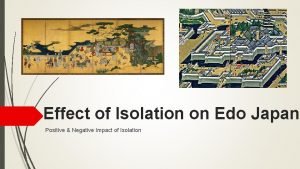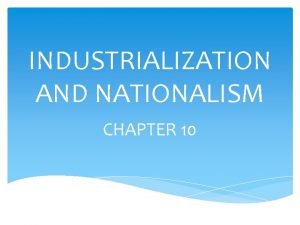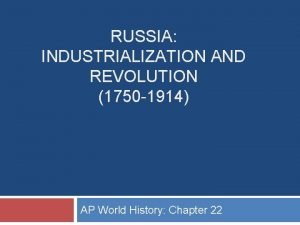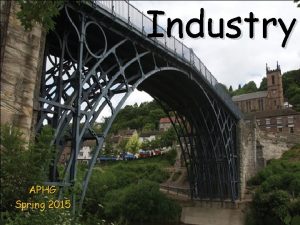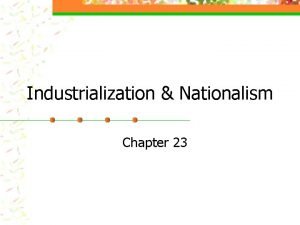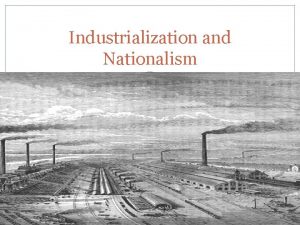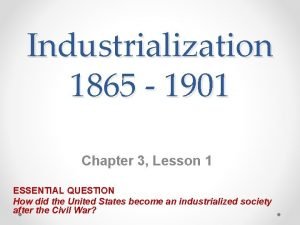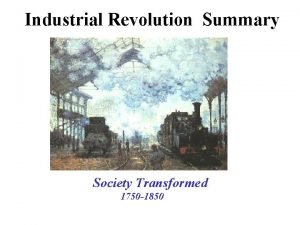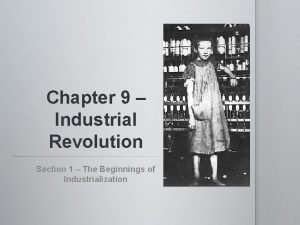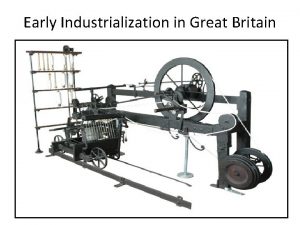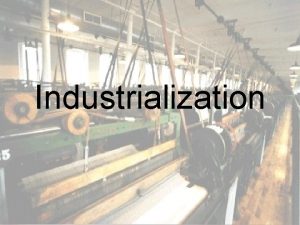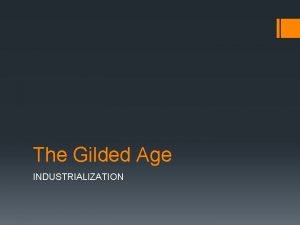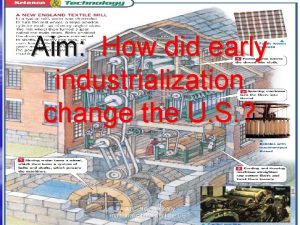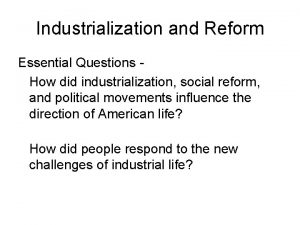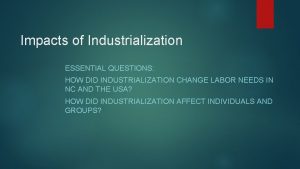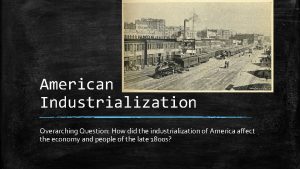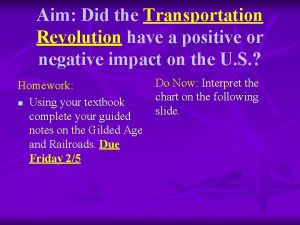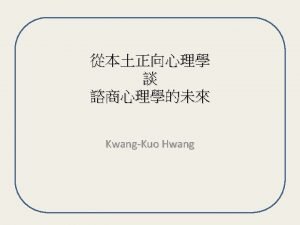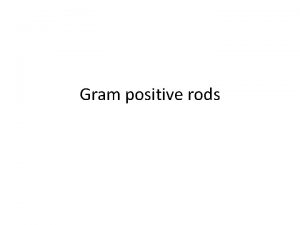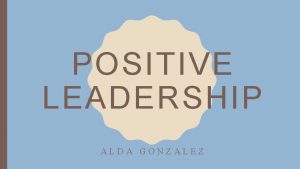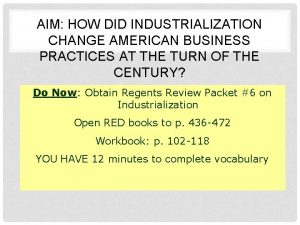Aim Did early industrialization have a positive or





















- Slides: 21

Aim: Did early industrialization have a positive or negative impact on the USA post-War of 1812? Essential Questions: 1. Why were the first factories located near fast moving water? 2. What is produced in textile mills? 3. What is mass production? 4. What are interchangeable parts?

H Spirit of Nationalism in US §Country is united, confident, and growing § 1791 -1819, 9 states joined the original 13. H One political party---Republican party H Respect from Europe H Monroe first president to visit all states H An “Era of Good Feelings” had began INDUSTRY EXPANDS

FIRST, the English Industrial Revolution… The Industrial Revolution began in England in the 1700’s Several English inventions encouraged America’s Industrial Revolution. . . Ø The spinning jenny Ø The water loom Ø The STEAM ENGINE: invented by James Watt – it provided energy to pump water out of mines, and run machines

First American Industrial Revolution • New England textile mills were expanding o. Mostly near fast moving water – Why? o. The moving water provided power for the machines in the early factories! o 240 textile factories by 1814 o. Provided the American population with cloth • Mass production • Interchangeable parts (Eli Whitney)

The Erie Canal 1825 o o Connects the Great Lakes with the Atlantic Ocean Cut transport costs by about 90% Massive population increase in western New York Farming products from the west could move more quickly to the east

The Erie Canal – The Locks

Clip from “America the Story of US” • Disc 1 – Chapter “Division” • 1 st Chapter about the construction of the Erie Canal • While watching the film take notes on the following question: What obstacles did the men face while constructing the Erie Canal? ERIE CANAL VIDEO

Steamboats & Canals • Mississippi & Ohio Rivers helped farmers get their goods to the East but there was no fast way to get manufactured goods to the West… • Robert Fulton – steamboat – connected the West with Northern manufacturing Steamboats provided upstream shipping with reduce costs & increased speeds

The Railroad • From 1840 to 1860, the greatest new transportation advancement… • RAPID and RELIABLE! • Challenged canals’ dominance • Stimulated industrial & commercial agricultural growth • Turned small western towns into BOOMING COMMERCIAL CENTERS (Cleveland, Detroit, Chicago)


The Railroad Revolution, 1850 s • Immigrant labor built railroads in the North • Slave labor built railroads in the South

Market Revolution • New national markets allow access to new goods and products • Made possible by the new forms of transportation… • URBANIZATION INCREASES!

Aim: How was the USA changed by the invention of the cotton gin? Essential Questions: 1. Why was cotton so important to the growth of the United States? 2. How did the cotton industry affect the South AND the North? The same? Or differently? WHY?

Eli Whitney’s OTHER critical invention = Cotton Gin (1793) Actually invented by a slave!

Cotton and the South Cotton gin transformed agriculture… ØCotton > tobacco and indigo ØCapital spent on slaves and new land ØSold most cotton to British textile factories Ø“KING COTTON” = economic dominance of the Southern cotton industry • "You daren't make war against cotton!. . . Cotton is king!"

America the Story of US “The Cotton Gin” VIDEO 1. 2. WHILE YOU WATCH: What were THREE impacts of the expansion of the cotton industry? How did slavery impact the lives of African Americans?

Slave Population, 1820 Slave Population, 1860 Slave Population, 1840

INTERESTING FACTS Cotton boom = increase in # of slaves (1 million in 1800 to nearly 4 million in 1860) Ø Many were smuggled…slave trade wasn’t allowed since 1808! Ø Deep South – slaves = 75 % of population Ø 1860 - 250, 000 African Americans in the south were FREE! HOW? ! Ø American Rev Ø Mulatto- liberated by white fathers Ø Self-purchase freedom (wages from side work) Ø Constantly show papers that they were free

EFFECTS of the Market Revolution on WOMEN • 1815: 65% of all U. S. clothing was made by women at home • 1840: textile manufacturing grew, especially in New England, due to a series of new inventions • The most famous factory was the Lowell Mill in Boston

The. Boarding Lowell System: Houses Lowell The 1 Dual-Purpose Textile Plant st Francis Cabot Lowell’s town - 1814

Lowell Girls • • END of self-sufficient households Young farm women (no longer needed on farms working next to men) • Domestic service OR teaching in cities What was their typical “profile? ” • DOCUMENT Mostly single. ANALYSIS: women – having less children • Still NO real legal/political rights
 Did isolation have a positive or negative effect on japan?
Did isolation have a positive or negative effect on japan? -have strength to match the growth of industrialization
-have strength to match the growth of industrialization Early cpr and early defibrillation can: *
Early cpr and early defibrillation can: * Pentagonal edges
Pentagonal edges S. agalactiae catalase test
S. agalactiae catalase test Negative number rules
Negative number rules Positive practice positive outcomes
Positive practice positive outcomes About early humans for class 6
About early humans for class 6 Import substitution industrialization
Import substitution industrialization Industrialization
Industrialization Russian revolution of 1905 definition ap world history
Russian revolution of 1905 definition ap world history What is outsourcing aphg
What is outsourcing aphg Industrialization spreads chapter 25 section 3
Industrialization spreads chapter 25 section 3 Chapter 9 section 3 industrialization spreads
Chapter 9 section 3 industrialization spreads Chapter 9 section 3 industrialization spreads answer key
Chapter 9 section 3 industrialization spreads answer key Revolution
Revolution Footloose industry
Footloose industry Lesson quiz 10-2 industrialization and nationalism answers
Lesson quiz 10-2 industrialization and nationalism answers Lesson 1 the rise of industry
Lesson 1 the rise of industry Result of industrialization
Result of industrialization American laws
American laws The beginnings of industrialization chapter 9 section 1
The beginnings of industrialization chapter 9 section 1
